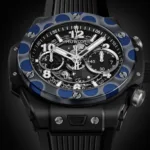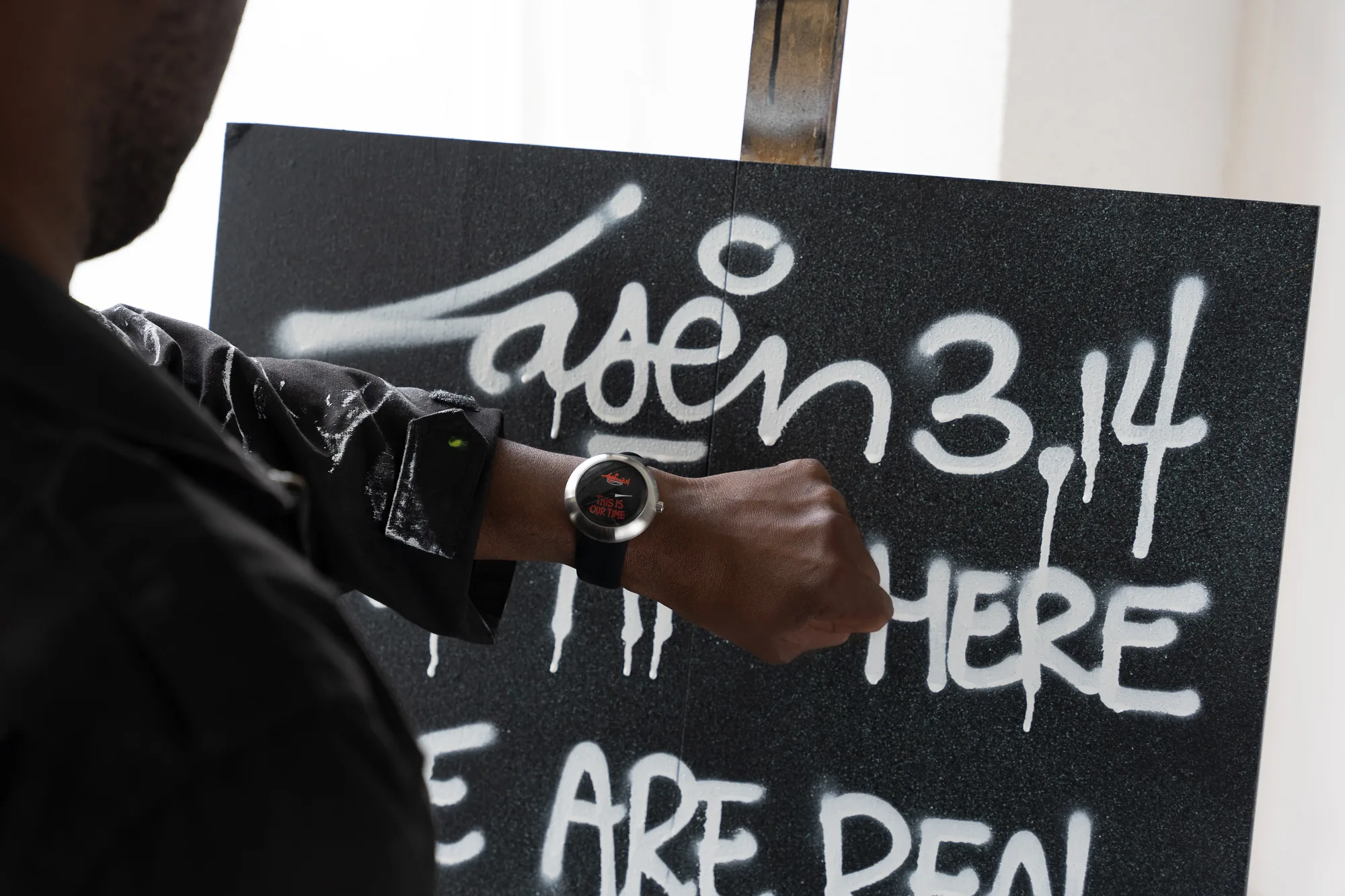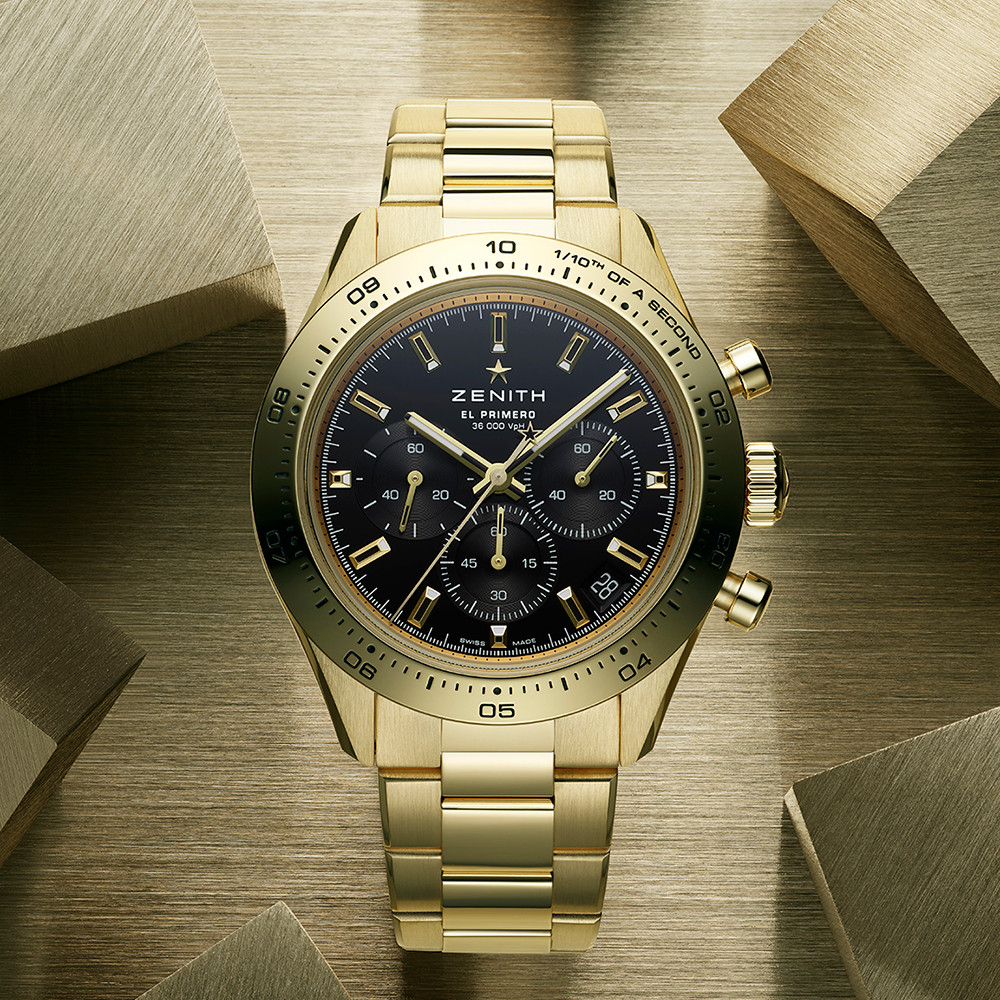After announcing the Louis Vuitton Watch Prize for Independent Creatives in early 2023, Louis Vuitton is embarking on a series of collaborative timepieces with esteemed independent watchmakers. The inaugural project of this endeavor is the LVRR-01 Chronographe à Sonnerie, a creation born from the collaboration between Atelier Akrivia and Louis Vuitton.
The LVRR-01, a true embodiment of both Maisons’ essence, is a double-faced chronograph with a chiming complication—a remarkable statement in the watchmaking industry. It is powered by a completely novel tourbillon movement meticulously developed by Atelier Akrivia’s founder, Rexhep Rexhepi, and ingeniously housed within a redesigned Louis Vuitton Tambour case.
The core concept behind the LVRR-01 is symbolized by an emblem on its sapphire dial. From a distance, it resembles the conventional Louis Vuitton logo, but upon closer inspection, the emblem unveils itself as a harmonious fusion of the two brand names. “LV” is subtly incorporated into “AKRIVIA.” This groundbreaking design marks the first instance in history where Louis Vuitton has blended its iconic logo with that of another distinguished brand.
Louis cruises with Rexhep
The LVRR-01 effortlessly brings together two esteemed houses, Louis Vuitton and Atelier Akrivia, although they stand separated by centuries in their inception, their shared fervor for craftsmanship serves as a unifying bond. Despite being established over 150 years apart, these two Maisons share fundamental values, particularly in their dedication to the art of craftsmanship, and are guided by visionary founders who are also true artisans.
Louis Vuitton, born in 1821 not far from the Swiss border, embarked on his journey when he relocated to Paris as a young man. There, he apprenticed with one of the renowned trunk makers of his era. Swiftly gaining recognition for his exceptional skill in crafting cases and trunks, he garnered esteemed clientele, including the Empress of France. In 1854, he founded his eponymous atelier and achieved such remarkable success that he eventually relocated to larger premises in Asnières, where the Louis Vuitton trunkmaking atelier continues to thrive to this day. As the adage goes, history never repeats itself precisely, but it often echoes.
On the other hand, Rexhep Rexhepi, hailing from Kosovo, ventured to Geneva as a teenager and embarked on an apprenticeship at a distinguished High Watchmaking atelier at the tender age of 14. In 2012, he founded his own brand, Atelier Akrivia, driven by the unwavering belief in producing watches in the esteemed tradition of Haute Horlogerie.
The shared ardor for the art of fine watchmaking set in motion a sequence of events culminating in the creation of the LVRR-01. This exceptional timepiece emerged in conjunction with the inception of the Louis Vuitton Watch Prize for Independent Creatives, a testament to the fusion of two distinct yet harmonious legacies.
A union of historic complications
The LVRR-01 serves as a profound exploration of the essence of time. It is a meticulously crafted precision chronometer, housing a tourbillon regulator that not only displays the current time with utmost accuracy but also functions as a stopwatch to measure elapsed time. Furthermore, it introduces a groundbreaking innovation to the watch industry by incorporating a sonnerie mechanism, marking the passage of time in a unique manner.
These remarkable complications are elegantly presented through a dual-faced design that beautifully encapsulates the collaborative spirit behind the LVRR-01. The contemporary front dial, crafted from tinted sapphire crystal, stands in captivating contrast to the traditional face on the reverse, meticulously executed in white grand feu enamel. This dual display serves as a symbolic representation of the rich identities of both Louis Vuitton and Atelier Akrivia, seamlessly melding modernity with tradition.
These complications hold a special significance, reflecting the historical legacies of both Louis Vuitton and Rexhep Rexhepi. The very first timepiece created by Atelier Akrivia, the AK-01, featured a combination of the chronograph and tourbillon, while Louis Vuitton’s initial venture into complex watchmaking, the Tambour LV277, was a pioneering chronograph. Notably, the Maison’s first foray into Haute Horlogerie complications was marked by the introduction of the tourbillon.
Pushing the boundaries of High Watchmaking
Within the LVRR-01 resides an entirely novel caliber, painstakingly crafted by the hands of Rexhep Rexhepi himself. True to his distinctive aesthetic sensibilities, the movement exudes a profound sense of tradition, a quality eloquently demonstrated by the meticulous hand-applied decorations and gracefully shaped chronograph levers.
The exceptional double-faced dial of the LVRR-01 necessitated an unconventional approach to the movement. Unlike conventional movements, the LVRR-01 caliber is ingeniously inverted, placing the chronograph and chiming mechanisms in full view on the front of the watch, rather than hidden on the back. This design choice allows the exquisite architecture and painstaking decorations to be perpetually admired upon the wrist.
The tinted sapphire dial offers a window into the impeccable craftsmanship of each component, every one of which is adorned by hand using time-honored techniques such as anglage and black polishing.
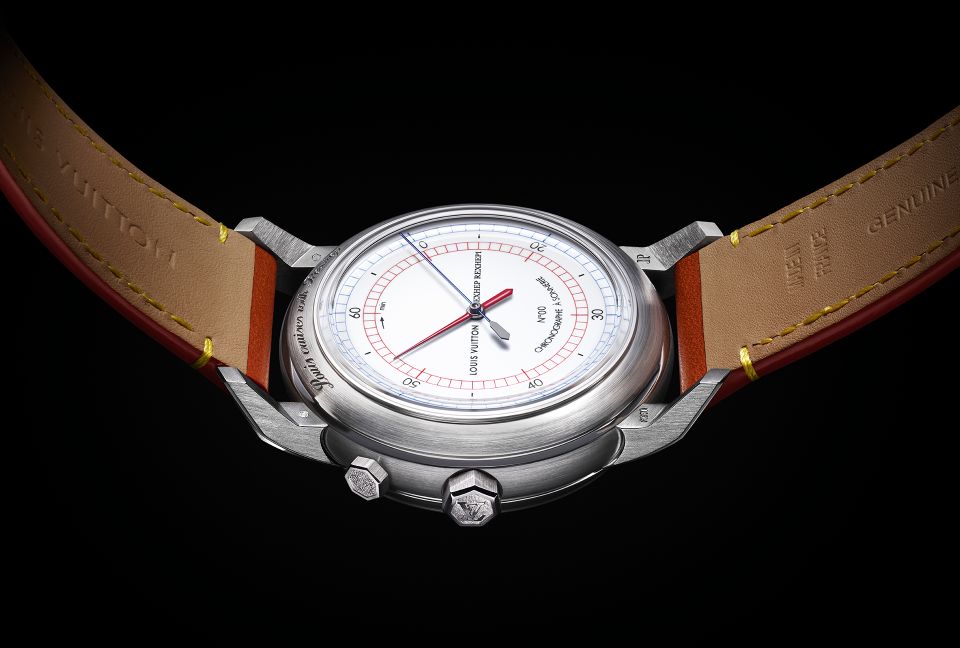
Taking center stage on the front dial, precisely at six o’clock, is the tourbillon—a masterpiece designed by Rexhep Rexhepi, characterized by its profound reverence for horological history. Unlike the one-minute rotation of a conventional tourbillon, this tourbillon completes a five-minute revolution, paying homage to historical chronometers. Within its cage resides a balance wheel with twin broad arms and eight inertial regulating weights, drawing inspiration from those found in marine chronometers.
The defining and unparalleled feature of this movement is the Chronographe à Sonnerie—a pairing of complications never before integrated in this manner within a wristwatch. While the combination of elapsed time measurement and a striking mechanism has historical roots in pocket watches, its presence in contemporary watchmaking is a truly remarkable statement.
The chronograph functions, including start, stop, and reset, are seamlessly controlled by the pusher at two o’clock. Yet, the chronograph boasts an additional auditory reminder of elapsed time, chiming a single note as each minute elapses. This melodious chime, clear and resonant, is produced by a black-polished steel hammer striking a tempered steel gong—developed at Atelier Akrivia—creating a harmonious sound signifying the passage of each 60 seconds.
Integrating these two intricate complications—the chronograph and the sonnerie—in addition to the tourbillon required a marriage of engineering and execution. These systems needed to work in perfect synergy while each receiving sufficient energy to operate.
Rexhep Rexhepi devised an elegant solution involving twin barrels, one serving as the power source for the timekeeping aspect of the movement and the chronograph, and the other dedicated to the sonnerie. However, there’s a clever twist to this arrangement. Instead of isolating the barrels and allowing them to run independently, Rexhep Rexhepi ingeniously linked the second barrel to the gear train in a specific manner, ensuring a harmonious dance of precision and complication.
Upon activation of the chronograph and the subsequent release of the central mobile by the hammer, an important transition occurs. The restraint on the rotation from the second barrel is lifted, allowing a continuous supply of energy to the base gear, even when the chronograph and striking mechanism are in operation. This clever mechanism ensures that the intricate complications receive a steady and uninterrupted energy flow, thus allowing them to function flawlessly without disrupting the overall movement.
Visible through the transparent sapphire dial is the mesmerizing mechanical choreography responsible for producing the melodious chimes. The sonnerie and second barrel are intricately connected to a secondary escapement equipped with jeweled pallets. This specialized escapement cyclically releases the energy stored in the second barrel, ensuring that the sonnerie strikes with utmost precision and regularity, creating a harmonious auditory experience.
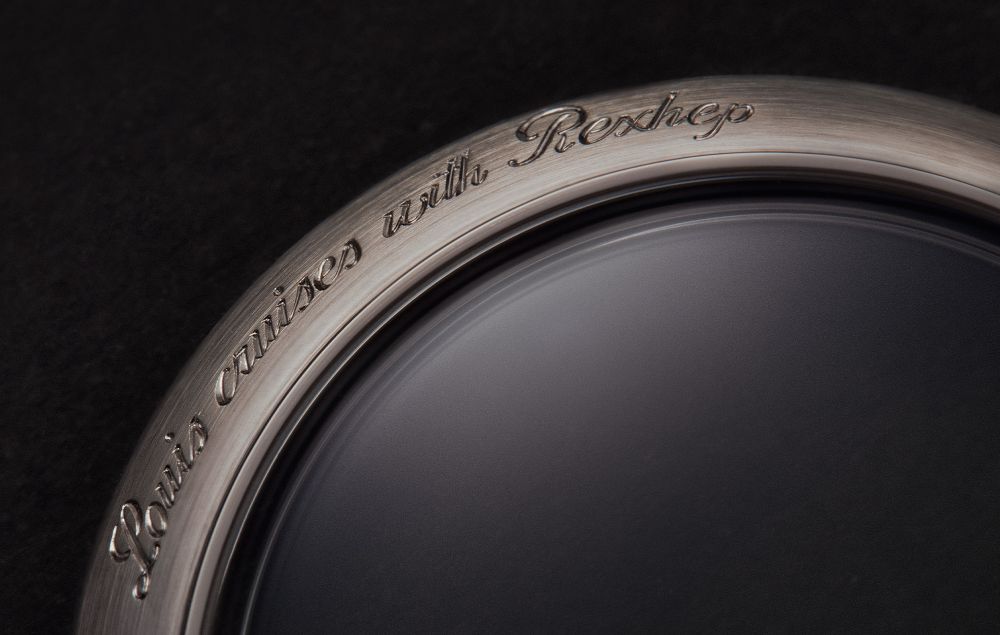
A case-making legend
The harmonious fusion of Louis Vuitton and Atelier Akrivia is seamlessly extended into the platinum case, representing a flawless marriage between Louis Vuitton’s iconic Tambour design and the stylistic finesse of Rexhep Rexhepi. Rexhepi’s influence is notably evident in the slim and classic silhouette of the case, which perfectly complements the Tambour’s signature shape.
In the LVRR-01, the traditional drum-shaped Tambour design undergoes a reinterpretation, evolving into a refined and contemporary form. This new rendition is characterized by a gracefully tall, sloping bezel and elegantly sculpted lugs that draw inspiration from the aesthetic sensibilities of mid-century gentlemen’s wristwatches.
The crown and chronograph pusher exhibit a distinct seven-sided design, taking inspiration from Louis Vuitton timepieces while bearing the meticulous craftsmanship of Atelier Akrivia. These components, reminiscent of the intricate parts within the movement, feature chamfered edges and are adorned with hand-hammered finishes—a technique expertly applied by Rexhep Rexhepi himself.
The case is meticulously crafted by Atelier Akrivia, under the watchful guidance of Jean-Pierre Hagmann, the Master casemaker in charge of their case-making workshop. With decades of experience under his belt, Jean-Pierre Hagmann’s discerning eye ensures that the case attains perfection in both form and detail. His personal hallmark, discreetly inscribed as “JHP” on the lower-right lug, serves as a testament to the unparalleled quality of his work.
As a subtle nod to the collaborative venture, the case back features the hand-engraved phrase “Louis cruises with Rexhep,” a calligraphic dedication symbolizing this exceptional encounter between two distinguished Maisons.
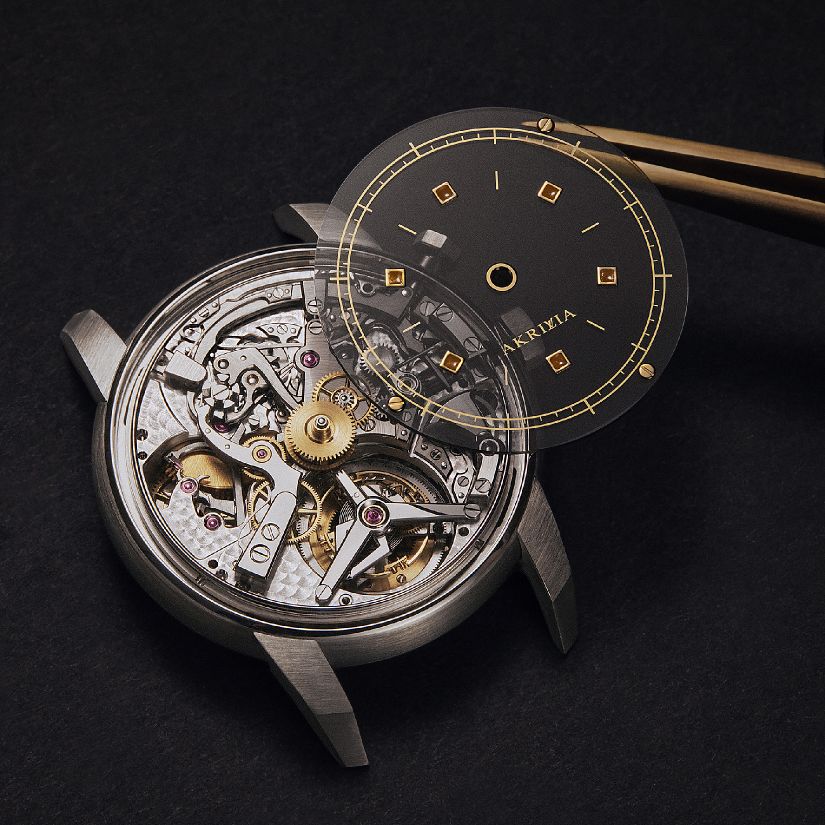
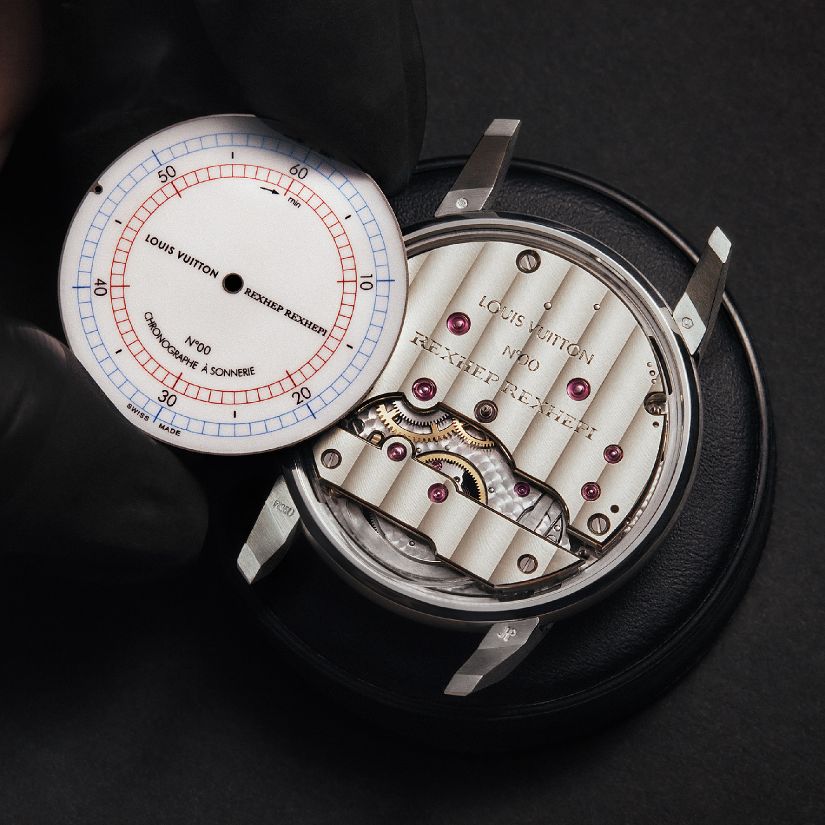
The many faces of time
The distinctive and individual aesthetic languages of Rexhep Rexhepi and Louis Vuitton are unmistakably present on both dials, yet they harmoniously meld into a seamless whole. The front dial, impeccably styled yet richly adorned, embodies a modern sensibility that mirrors the contemporary identity of Louis Vuitton. Crafted from a disc of tinted sapphire crystal, it showcases a gilt-metallized minute track reminiscent of the Rexhep Rexhepi Chronomètre Contemporain (RRCC I & II).
This dial boasts six gold cubes, each filled with translucent fired enamel—an artistic technique reminiscent of stained glass known as “plique-à-jour.” The cubic motif pays homage to Louis Vuitton’s patented complication, the Spin Time jumping-hours display. Simultaneously, the presence of these gold elements discreetly acknowledges the yellow thread stitching, a subtle yet essential attribute found in Louis Vuitton’s renowned leather goods.
In contrast, the reverse face exudes a resolute classical charm with its glossy white grand feu enamel, a nod to traditional measuring instruments. Designed by Rexhep Rexhepi and meticulously crafted by Nicolas Doublel, the in-house enameler at La Fabrique du Temps Louis Vuitton, this enamel dial harks back to 19th-century chronograph pocket watches. It features twin scales for hours and minutes, both intricately printed in enamel. Astute observers will note that the design of this enamel dial carries the spirit of Louis Vuitton’s very first wristwatch, crafted in 1988.
Both brand names intersect the enamel dial horizontally, reflecting the collaborative nature of the watch in both style and substance. While Atelier Akrivia produces the white-gold disc serving as the base for the dial, the enameling process is meticulously completed by the in-house enamel atelier under the guidance of Nicolas Doublel.
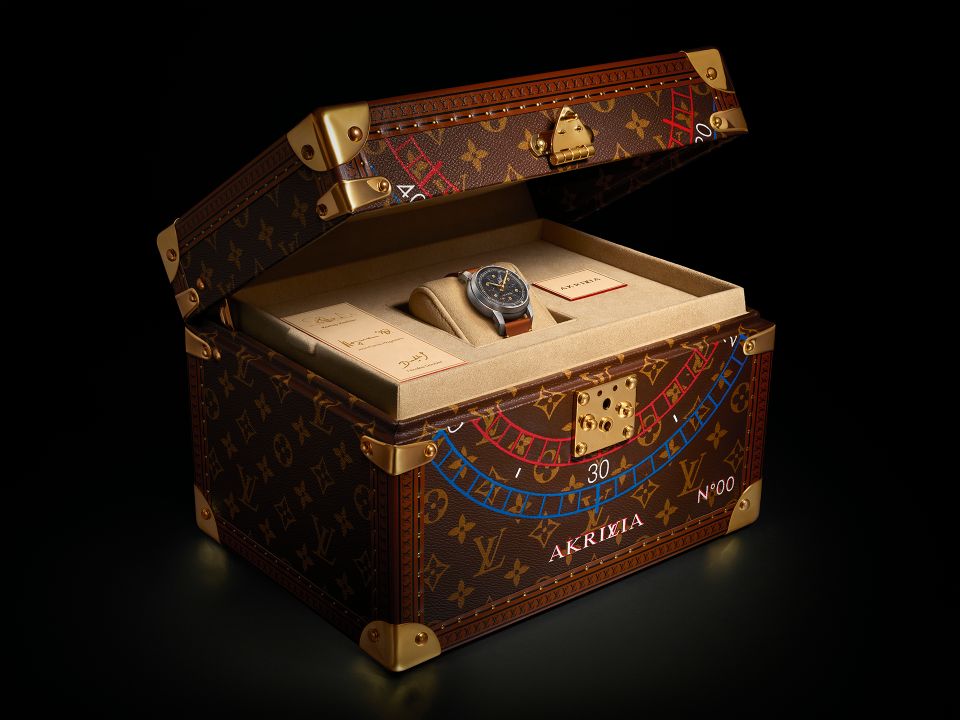
A singular trunk for a unique watch
The LVRR-01 arrives in a one-of-a-kind Louis Vuitton traditional trunk, individually tailored for each watch. Each trunk undergoes meticulous hand-painting, featuring a motif inspired by the chronograph scales found on the enamel dial. It also proudly displays the “AKRILVIA” logo and the unique serial number corresponding to the watch. As a final touch and homage to the artisans responsible for the LVRR-01, the trunk proudly showcases the signatures of Rexhep Rexhepi, Jean-Pierre Hagmann, and Nicolas Doublel.
Completing the ensemble, the LVRR-01 comes with a Louis Vuitton strap crafted from natural cowhide leather. This calfskin strap develops a graceful patina with use, adding character over time. It is fastened with a distinctive platinum pin buckle, meticulously fashioned by the skilled craftsmen in the workshop of Jean-Pierre Hagmann, bearing his hallmark “JHP” as a mark of excellence.
For more information, please visit Akrivia.com.
